Home Park
Home Park is a football stadium in Plymouth, England. The ground, nicknamed the Theatre of Greens, has been the home of Football League One club Plymouth Argyle since 1901.[3]
Theatre of Greens | |
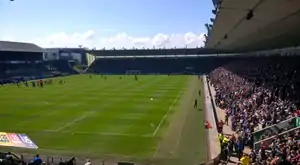 The view of the ground from the Family Corner prior to the Grandstand renovation | |
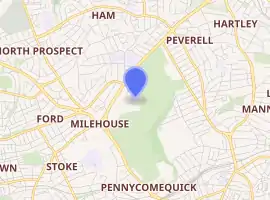
| |
| Location | Plymouth, PL2 3DQ Devon, England |
|---|---|
| Coordinates | 50°23′17″N 4°09′3″W |
| Owner | Plymouth Argyle |
| Operator | Plymouth Argyle |
| Capacity | 18,600[1] |
| Record attendance | 43,587 |
| Field size | 105 x 70 m[2] (114 x 78 yd) |
| Surface | Fibrelastic Rootzone (Grass) |
| Scoreboard | None |
| Construction | |
| Built | 1892 |
| Opened | 1893 |
| Renovated | 2001 & 2019 |
| Construction cost | £11m (2001) & £10m (2019) |
| Architect | Barr Construction (2001) & GL Events (2019) |
| Tenants | |
| Plymouth Argyle (1901–present) | |
After undergoing considerable development in the 1920s and 1930s, the ground suffered heavy damage in World War II. It reopened in time for the resumption of the Football League in 1945, and underwent further improvements in the 1950s, including the installation of floodlights and a new double-decker grandstand. The ground remained relatively unchanged until 2001, when construction of three new all-seater stands began.[4] The work was completed in 2002, and after further work the stadium became all-seater in the summer of 2007.[5]
The stadium's record attendance was in 1936, when 43,596 spectators watched the club play a Second Division match against Aston Villa. The record average attendance for a single season, 23,290, came in the 1946–47 season.[6] The stadium was selected as part of England's 2018 FIFA World Cup bid by the FA in December 2009.[7][8] The ground has played host to England youth internationals, and a UEFA Cup Winners' Cup match between Saint-Étienne and Manchester United in 1977.[9] Home Park has also hosted Rugby union and athletics, and live music in the summer, with Elton John, George Michael and Rod Stewart among the acts who have performed at the ground.[10]
Stands
| Stand | For | Capacity |
|---|---|---|
| Mayflower Stand | Home Fans | 5,093 (seated) |
| Devonport End | Home Fans | 2,832 (seated) |
| Lyndhurst Stand | Home Fans | 7,072 (seated - includes Family Corner) |
| Barn Park End | Home & Away Fans | 2,907 (seated) |
The Mayflower stand, known as the Grandstand, reopened fully on 1 January 2020 following a significant refurbishment. The other three stands are each very similar in design and are linked together at the corners, having been built in 2001.
The Devonport End houses the more vocal of the club's supporters.[11] The Lyndhurst Stand is the largest of the three stands, holding about 7,000 spectators, including the corners. The corner towards the East side of the ground is now the dedicated family corner. The Barn Park End is where the away supporters are housed. It holds about 3,000 spectators. The standard allocation given to visiting clubs had previously been 1,300, and this had been increased in the past whenever demand required it. although only 1,300 tickets were issued to away fans for the upcoming 2018–19 season.[12]
All three stands have good views and standard facilities for a football stadium, including concourses, merchandise stands and food and drink outlets. The pitch measures about 100 metres (109 yards) long by 66 metres (72 yards) wide, with a few metres of run-off space on each side. The ground also has two pitch covers, rain and frost, to protect the pitch against adverse winter weather.
History
Construction and early years
Home Park was originally used by the now defunct Devonport Albion rugby team from 1893 to 1898. Following a dispute with the ground's owners over rent, Albion left and the ground was not used for three years. In 1901 the Argyle Athletic Club obtained a lease on the ground, then an oval-shaped bowl and cinder track surrounded by allotments and farmland.[13] The new owners staged their first event, an athletics meeting, on Whit Monday in 1901, however, leaseholder Clarence Spooner was keen for it to stage football. Following a series of successful trial matches involving Argyle Football Club, which attracted healthy crowds, Spooner made the decision to focus on establishing the first professional football club in Devon.[3] The club, formed in 1886, changed its name to Plymouth Argyle in 1903 and became professional that same year. Home Park played host to its first competitive match, against Northampton Town, on 5 September 1903 in front of a crowd of 4,438. At the time the ground had one wooden grandstand which could accommodate 2,000 people, while the other three sides of the ground were surrounded by slag heap banking with a waist-high fence. When Argyle joined the Football League in 1920 several improvements were required to meet safety requirements.[3]
The wooden grandstand was demolished and replaced by a much larger and more modern structure at a cost of £12,000, while concrete terracing with crush barriers were added around the other three sides of the ground. A pitched roof was erected along the main entrance at the Devonport End of the ground, to provide cover for supporters using that terrace. The new grandstand incorporated players changing rooms and club offices. Many of these facilities were built with funds provided by the official supporters club.[3] By the 1930s the ground was regularly hosting crowds in excess of 20,000 and on 10 October 1936 the record attendance was set. A crowd of 43,596 were in attendance to watch the club play out a 2–2 draw with Aston Villa in the Football League Second Division. The ground continued to host Second Division football until the outbreak of war in 1939.[14]
Wartime bombing
The city of Plymouth was hit hard during the Second World War due to its strength as a military base: HMNB Devonport was the largest naval base in Western Europe.[15] As the ground was so close to the city centre and Plymouth Sound, it was unlikely that it would escape unharmed. The Football League was abandoned three games into the 1939–40 season, but Home Park continued to host matches until summer 1940 in the hastily organised South West Regional League.[16] In April 1941 there was a series of Luftwaffe bombing raids on the city, known as the Plymouth Blitz; Home Park did not escape. The Grandstand was all but destroyed after sustaining multiple hits and the pitch was littered with impact craters, which left the club facing a major rebuilding operation when the war ended in 1945.
Post-War
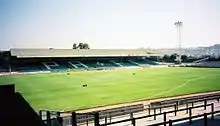
Several drastic measures were required to be ready for the resumption of a regionalised Football League in 1945. Disused army huts were used as changing rooms, buses and trams were used as offices, and railway sleepers were used for terracing.[3] The Football League was still split into North and South divisions, having been created four years earlier in order for the League to continue whilst limiting the amount of travel by teams during the war. The 1945–46 season was its only full campaign. Records from this time tend not to be included in official records. Plymouth Argyle's first official match back at the ground for six years was played on 31 August 1946. 25,659 spectators watched a 3–1 victory against West Ham United in the Second Division.[17]
A new double-decker Grandstand was built in 1952, one of the last to be based on the template made popular during the 1920s and 30s by prolific football stadium architect Archibald Leitch, with floodlights installed in October 1953.[13] Running the length of the pitch, it had standing room in the first tier, known as the Mayflower Terrace, and wooden seating in the second tier.[18] When a roof was erected on the Lyndhurst side of the ground in 1964, three quarters of the ground were under cover, with all but the second tier of the Grandstand being standing room. In the 1969–70 season seats were added at the back of the Mayflower Terrace, which took the seating capacity to 4,100 and the overall capacity to 40,000.[13] In the late 1970s the pitched roof at the Devonport End of the ground had to be removed for safety reasons.[3] It was replaced in 1984 by a non-pitched structure, leaving just the Barn Park End uncovered.[19]
The ground remained relatively unchanged throughout the 1990s, aside from the Lyndhurst Stand being made all-seater. However, its future seemed unclear when the club outlined plans to move to a new site in Central Park in 1996. The Plymouth Tradium, designed by Alfred McAlpine, would have seated 25,000, and also incorporated community sports and leisure facilities.[20] In the end nothing came of it and the club instead focused on redeveloping Home Park, with many parts of the old ground showing their age by the start of the 21st century.
2001-02 redevelopment
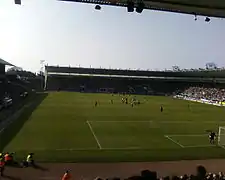
A new plan, based on wholesale redevelopment of the existing ground, was announced in 2000 which at the time would cost an estimated £9m. The stadium would be built in two phases, with the first phase seeing the complete redevelopment of the Devonport End, Lyndhurst Stand, and Barn Park End. The second phase involved the Mayflower Grandstand which would be replaced by a new three-tiered structure to complete an 18,500 capacity all-seater bowl.[21] The green light came in June 2001 when the club and Plymouth City Council agreed a new long-term lease for the ground. The building firm Barr Construction moved onto the site two months later.
During the first six months of the 2001–2002 season supporters watched the club's matches from one touchline before the first phase was completed in February 2002.[22] One of the biggest attendances since the redevelopment was set on 20 April 2002, as 18,517 spectators watched Plymouth Argyle recorded a 2–0 win against Cheltenham Town in the Third Division.[23] A feat which was bettered in 2004, and then in 2007. Home Park attracted its highest average league attendance for over forty years during the 2004–05 season in the Championship, formerly known as the First Division.[24] Despite this, a start date for the second phase of redevelopment would not materialise. The former chairman of Plymouth Argyle, Paul Stapleton, declared that not completing the project was the biggest disappointment of his tenure.[25]
Freehold purchase and conversion to all seater
The club purchased the freehold of the ground from Plymouth City Council to become sole owners in December 2006 for £2.7m.[26] It was hoped that work on a new Grandstand would begin the following year. It hosted its biggest crowd since the redevelopment in March 2007 when 20,652 were in attendance to watch Argyle play Watford in the quarter-finals of the FA Cup.[27] That summer the ground became all-seated as the club was forced to convert the Mayflower Terrace into seating by the Department for Culture, Media and Sport.[28] In the aftermath of the Hillsborough disaster in 1989 regulations were brought in, recommended by the Taylor report, that all stadiums in the top two divisions of English football must be all-seated unless there are exceptional circumstances. The club had been given three years grace after winning promotion back to the Football League Championship in 2004.
Three major summer initiatives were announced by the club just over a week later, which were carried out over the next month.[29] The Mayflower Terrace was replaced by temporary, unreserved seating with a capacity of 3,500. A new state-of-the-art public address system was installed, and the last of ground's iconic floodlight towers were dismantled after 54 years of service, with a new system put in its place.[30] The capacity of the ground was therefore reduced by roughly two thousand to 19,500 following these changes.
Council ownership
On 4 March 2011, the club entered administration.[31] As part of a rescue package, which saw South West hotelier James Brent take over the club,[32] Plymouth City Council agreed to buy back the freehold for a reported £1.6m and lease the ground back to the club for an annual rent of £135,000.[33]
With new investment and directors on the Argyle board, the club could afford to buy-back the ground from the Council in 2016.[34]
2018-19 redevelopment
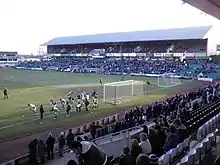
The Mayflower Grandstand was the club's main stand, with space for about 7,000 spectators including the old terrace. It is the oldest part of the ground, having been built in 1952. It houses the club's main offices, the boardroom, team changing rooms and press rooms, and also accommodates executive boxes.[35] The player tunnel sits slightly off centre going underneath the Mayflower, leading up towards the changing rooms.[36]
There had been plans to replace this stand for a number of years.[37] In 2013, planning permission was finally given to revamp and rebuild the Mayflower Grandstand. No work however was carried out until 2018 when the redevelopment of the Grandstand and the surrounding area began.[38] The main redevelopment would include the fitting of new seats in the top tier, replacing the antiquated wooden ones, fitting new seats on the terrace, and replacing the roof. For players, there would be a new changing room block and a new tunnel to the East side of the ground in the corner of the Grandstand and the Barn Park End.[39]
The Grandstand was subsequently shut to spectators for the entirety of the 2018-19 season, severely reducing Home Park's capacity. To each side of the stand there used to stand two separate buildings, to the east was the Chisholm Lounge which was used for hospitality, as a press area and was home to the Argyle disc jockey until its demolition in August 2018.[40] Behind the Chisholm Lounge was the supporter's bar, known as the 'Far Post Club'. This was also demolished to make way for a new supporter's bar, to be funded by fan group 'The Green Taverners'.[41] To the west of the Grandstand was a disabled enclosure, which too was demolished to make way for new buildings, this time for a new club shop.
The club store façade was given a new look in October 2019 by Marcus Rees, a graphic design student at the Plymouth College Art, and local business, Eagle Signs.[42] According to Rees, the signage was designed to, "pay homage to the original design, which was made out of bronze."[43]
Unsuccessful World Cup Bid
In August 2009 the club announced plans for wholesale development of the stadium and regeneration throughout the area.[44] The club declared that the city of Plymouth would be submitting an application to the Football Association (the FA) to be a host venue for England's 2018 FIFA World Cup Bid.[45] The eye-catching plans were released to the public on 14 December 2009, two days before the FA would announce which candidates they had selected for the bid.[46] The plans, designed by Populous, include developing the stadium into a 46,000 capacity all-seater area, with a 5,000-seat indoor facility and hotel built into the complex, at a cost of at least £50m.[47] The build would be done in three stages. The First Phase, a new Mayflower Stand, will become a reality regardless of the bid, increasing the capacity to 27,000. The Second Phase, an additional 8,000 seats, and the Third Phase, an additional 11,000 seats, would be completed by the 2014–15 season should Plymouth's application and England's bid be successful, giving the stadium a capacity of 46,000 all-seated by this stage.[48][49]
Simon Inglis[30]
The city presented its bid at Wembley Stadium in November 2009 with numerous businesses and sports clubs from Devon and Cornwall fully behind it.[50] A selection of those included the city's rugby union and basketball clubs, Plymouth Albion,[51] and Plymouth Raiders,[52] and local football clubs Exeter City,[53] and Torquay United.[54] Plymouth was selected as a part of England's 2018 FIFA World Cup Bid, alongside 11 other cities on 16 December 2009.[55] Plymouth Argyle director Paul Stapleton described himself as being overwhelmed, going on to say that getting over the first hurdle "gives our supporters belief that we can achieve things", while the bids chairman, Douglas Fletcher, described the bid as one "for the people of Devon and Cornwall".[56][57] A day later the club revealed that the stadium could possibly be renamed for sponsorship reasons as a part of funding for the project which shall begin in the summer of 2010.[58]
However, on 2 December 2010 England lost its World Cup bid to Russia.[59] Following the failure of the World Cup bid, the consortium that had taken controlling interest in the club in 2009[60] quickly lost interest now property speculation was out of the question and a few months later the club entered administration.[61]
Other uses
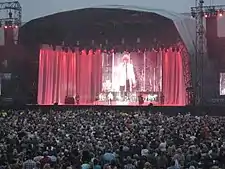
The stadium has also hosted matches involving the England national team at various levels. The England Amateur team played 4 matches against other national teams,[62](p4) twice against their Welsh counterparts in 1914 winning 9–1[62](p56) and 1925 winning 2–1,[62](p72) Italy in 1972 winning 4–0,[62](p317) and Finland in 1973, again winning, this time 3–0.[62](p322) The Amateurs also played a match against Plymouth Argyle, on 1972-11-13, winning 2–1 with an attendance of 830.[62](p319) A FA Amateur XI beat a South Western Football League XI 7–3 in 1954.[62](p185) Home Park also hosted three England Under-23 matches in the 1960s and 1970s. A 6–1 win against Belgium in 1962, a 4–1 win against Bulgaria in 1970 and a 0–0 draw with Poland in 1973.[63] In March 2015, more than 11,000 people watched the England U-20s play out a 2-1 friendly win over the USA U-20s.[64]
The final of the 1933–34 Football League Third Division South Cup was held at Home Park,[65] Exeter City beating Torquay United 1–0.[66]
The ground hosted a match in 1966 between representative sides of the Football League and the Irish Football League. A crowd of 35,458 were in attendance as the Football League, featuring seven members of the 1966 FIFA World Cup winning squad, were 12–0 victors.[67]
On 5 October 1977, Home Park hosted Manchester United's European Cup Winners' Cup first round second leg tie against AS Saint-Etienne of France. United won the game 2–0 (3–1 on aggregate).[68] Despite being based nearly 300 miles away at Old Trafford in Manchester, United had played their "home" tie at Home Park as UEFA had ordered them to play at least 120 miles from Old Trafford due to hooliganism incidents at the first leg in France, for which they had initially been expelled from the competition completely and only readmitted on appeal.[69]
Home Park has also been used for purposes other than football. Before Argyle moved in, the site was used for rugby union matches, and it hosted an athletics meeting in the early 20th century.[3] Rugby returned in 1951[70] when South Africa played the South West Counties, winning 17–8.
Plymouth Argyle was limited in what it could do with the stadium throughout the 1900s, because of a long-standing lease agreement with the City Council. That changed in 2006 when the club purchased the freehold of the ground for £2.7m.[71] Soon after, the club announced it would begin hosting live music in the summer months, starting in 2007, and the first act to perform there was Elton John.[72] Other major acts have followed, including George Michael, Meat Loaf, Westlife, and Rod Stewart.[73] The stadium also hosts an annual free-admittance carol service in December to celebrate Christmas, in association with the Plymouth branch of Christian organisation Faith and Football.[74] Westlife will be performing again in the stadium on 4 July 2020 for their "Stadiums in the Summer Tour".
In July 2018, with help from Plymouth City Council, the ground was used to screen England's World Cup semi-final defeat to Croatia at no charge for spectators.[75]
During the COVID-19 pandemic, areas of the Mayflower Grandstand, as well as the players' changing rooms, were handed over to the University Hospitals Plymouth NHS Trust to hold routine antenatal & phlebotomy services, in an attempt to relieve strain on Derriford Hospital and local GP surgeries. "With staff currently working from home and no football in the immediate future, offering up Home Park for the use of the NHS is, we feel, our civic duty," said club CEO Andrew Parkinson.[76]
Records
The highest attendance recorded at Home Park is 43,596 for a Football League Second Division match between Plymouth Argyle and Aston Villa on 10 October 1936.[77] This was before the ground was converted to an all-seater stadium, allowing many more people to fit into the stadium. Home Park's record attendance as an all-seater stadium currently stands at 17,511, set at a Football League Championship match between Plymouth Argyle and Watford on 22 March 2008.[78] Home Park's record attendance for a non-competitive match is 37,639, for a mid-season friendly between Plymouth Argyle and Santos on 14 March 1973.[79] The lowest recorded attendance for a competitive match at Home Park was 944, set on 10 December 1996, for a Football League Trophy first round tie between Plymouth Argyle and Bournemouth.[77] The highest average attendance at Home Park over a League season is 23,290, set in the 1946–47 season.[80] The lowest average attendance at Home Park came in the 1982–83 season, when an average of 4,537 spectators watched each match.[77]
Transport
Adjacent to the Devonport End of the stadium is the Milehouse Park and ride car park, with numerous services provided by Stagecoach South West serving the City Centre all the way up to Tavistock. Target Travel run three football special buses on matchdays serving Plympton via the A38, Plymstock via Mutley Plain, and the George Junction Park & Ride to the north of the city. The stadium is on Outland Road, which links to the A38 dual-carriageway with direct access to Cornwall and the north of England.[81] On foot, the stadium is approximately 1.6 miles (2.5 km) from Plymouth railway station and 1.8 miles (2.8 km) from the city centre.[82]
References
- https://www.plymouthherald.co.uk/sport/football/football-news/plymouth-argyle-home-park-capacity-1846560
- Pitch Dimensions Soccerbase. Retrieved 21 January 2010.
- The Home Park Story Greens on Screen. Retrieved 16 January 2010. Archived 9 May 2008 at the Wayback Machine
- 2001 Redevelopment Greens on Screen. Retrieved 16 January 2010.
- No Standing Room Plymouth Argyle FC. Retrieved 16 January 2010. Archived 27 May 2012 at the Wayback Machine
- Argyle Seasons Greens on Screen. Retrieved 16 January 2010.
- England's 2018 World Cup Bid BBC Sport. Retrieved 16 January 2010.
- New Home Park Western Morning News. Retrieved 16 January 2010. Archived 23 July 2011 at the Wayback Machine
- European Cup Winners' Cup Manchester United FC. Retrieved 16 January 2010.
- George Michael at Home Park Plymouth Argyle FC. Retrieved 16 January 2010. Archived 5 January 2009 at the Wayback Machine
- Family Area Plymouth Argyle FC. Retrieved 18 January 2010. Archived 27 December 2009 at the Wayback Machine
- The Away End Archived 24 July 2011 at the Wayback Machine Football Ground Guide. Retrieved 18 January 2010.
- The 100 Football Grounds 100 Grounds Club. Retrieved 16 January 2010.
- The Plymouth Blitz Plymouth Data. Retrieved 18 January 2010.Moseley, Brian (April 2011). "Plymouth Blitz – The March Raids". The Encyclopaedia of Plymouth History. Plymouth Data. Archived from the original on 3 December 2013. Retrieved 15 February 2015.
- HMNB Devonport Royal Navy. Retrieved 16 January 2010. Archived 14 April 2009 at the Wayback Machine
- 1939–40 Season Greens on Screen. Retrieved 16 January 2010.
- 1946–47 Season Greens on Screen. Retrieved 17 January 2010.
- Home Park 100 Grounds. Retrieved 17 January 2010.
- Home Park Pre-2001 Football Stadiums. Retrieved 18 January 2010.
- Plymouth Tradium CN Plus. Retrieved 17 January 2010.
- Groundtastic Greens on Screen. Retrieved 17 January 2010.
- 2001–02 Season Greens on Screen. Retrieved 17 January 2010. Archived 1 April 2010 at the Wayback Machine
- 2001–02 Champions Greens on Screen. Retrieved 17 January 2010.
- 2004–05 Season Greens on Screen. Retrieved 17 January 2010. Archived 1 April 2010 at the Wayback Machine
- Passing On The Baton Plymouth Argyle FC. Retrieved 17 January 2010. Archived 5 August 2009 at the Wayback Machine
- Argyle Complete Buy-Out BBC News. Retrieved 18 January 2010.
- 2006–07 FA Cup Quarter-Finals Greens on Screen. Retrieved 18 January 2010. Archived 28 May 2012 at the Wayback Machine
- No Standing Room Plymouth Argyle FC. Retrieved 18 January 2010. Archived 27 May 2012 at the Wayback Machine
- Sit, See And Hear Plymouth Argyle FC. Retrieved 18 January 2010. Archived 27 May 2012 at the Wayback Machine
- Home Park Greens on Screen. Retrieved 21 January 2010.
- BBC Sport: Plymouth enter adminsistation
- BBC Sport: James Brent completes Plymouth take over
- BBC Devon: 'Plymouth Argyle Home Park stadium deal agreed'
- "Plymouth Argyle set to buy back Home Park from city council in £1.7m deal". 26 September 2016.
- Commercial Facilities Plymouth Argyle FC. Retrieved 18 January 2010. Archived 28 January 2010 at the Wayback Machine
- "Archived copy". Archived from the original on 23 January 2010. Retrieved 4 April 2017.CS1 maint: archived copy as title (link)
- Phase Two Greens on Screen. Retrieved 18 January 2010.
- "Home Park development given go-ahead by Plymouth City Council". 14 December 2017.
- "Signed and Sealed". 8 August 2018.
- "The Chisholm Lounge is next to be demolished at Home Park". 4 June 2018.
- "The Best Bar None". 29 January 2018.
- "Superstore Sign". www.pafc.co.uk. Retrieved 18 June 2020.
- "Superstore Sign". www.pafc.co.uk. Retrieved 18 June 2020.
- Plymouth Bids To Stage World Cup The Herald. Retrieved 21 January 2010. Archived 24 February 2012 at the Wayback Machine
- Argyle's World Cup Bid Plymouth Argyle FC. Retrieved 21 January 2010. Archived 22 July 2011 at the Wayback Machine
- The New Home Park The Herald. Retrieved 21 January 2010. Archived 24 February 2012 at the Wayback Machine
- £50m Redevelopment Western Morning News. Retrieved 21 January 2010. Archived 23 July 2011 at the Wayback Machine
- Home Park Vision Plymouth Argyle FC. Retrieved 21 January 2010. Archived 13 September 2011 at the Wayback Machine
- A Compelling Bid Plymouth Argyle FC. Retrieved 21 January 2010. Archived 16 September 2009 at the Wayback Machine
- Plymouth Presents Its Bid The Herald. Retrieved 21 January 2010. Archived 28 January 2010 at the Wayback Machine
- Albion Prop Bid Plymouth Argyle FC. Retrieved 21 January. Archived 29 August 2012 at the Wayback Machine
- Raiders Support Argyle Vision Plymouth Argyle FC. Retrieved 21 January 2010. Archived 29 August 2012 at the Wayback Machine
- Exeter Backs Bid The Herald. Retrieved 21 January 2010. Archived 24 February 2012 at the Wayback Machine
- United Backs Bid Torquay United FC. Retrieved 21 January 2010. Archived 3 November 2009 at the Wayback Machine
- Cities Chosen for England 2018 Bid BBC Sport. Retrieved 21 January 2010.
- Plymouth To Prosper From Bid BBC Sport. Retrieved 21 January 2010.
- Plymouth Gets Green Light Plymouth Argyle FC. Retrieved 21 January 2010. Archived 29 August 2012 at the Wayback Machine
- Name Change Likely BBC Sport. Retrieved 21 January 2010.
- BBC Sport: England loses world cup bid to Russia
- BBC Sport: Consortium takes controlling stake in PAFC
- BBC Sport: Plymouth Argyle enter administration
- McColl, Brian; Gorman, Douglas; Campbell, George (2017). UK Amateur International Football: The Complete Record 1901-1974 (2nd ed.). ISBN 978-1-326-35601-9.
- England Under-23 Internationals RSSSF. Retrieved 22 January 2010.
- FA. Retrieved 25 June 2015.
- "Rare pre-war football medal to raise £350 at auction". This is Cornwall. 6 November 2010. Archived from the original on 12 September 2012. Retrieved 27 November 2010.
- "English Division Three South Cup". Statto. Archived from the original on 4 December 2008. Retrieved 12 November 2016.
- Representative Results ILG. Retrieved 22 January 2010.
- "Manchester United matches » 5 October 1977 European Cup Winners Cup vs St Etienne". Archived from the original on 7 July 2011. Retrieved 15 March 2011.
- Plymouth Argyle - Euro Game At Home Park
- Official Programme.
- Freehold Purchase Plymouth City Council. Retrieved 20 January 2010.
- Great Gigs In The Park The Herald. Retrieved 20 January 2010. Archived 9 February 2009 at the Wayback Machine
- Rod To Play Home Park The Herald. Retrieved 20 January 2010. Archived 9 February 2009 at the Wayback Machine
- Carol Service for Argyle Faithful The Herald. Retrieved 20 January 2010. Archived 17 January 2010 at the Wayback Machine
- "It's Coming: Home Park". 10 July 2018.
- "NHS @ Argyle". pafc.co.uk. 27 March 2020. Retrieved 1 April 2020.
- Attendances Greens on Screen. Retrieved 21 January 2010.
- Argyle vs Watford, March 2008 Soccerbase. Retrieved 21 January 2010.
- Argyle 3, Santos 2 Greens on Screen. Retrieved 16 January 2010.
- Highest Average Greens on Screen. Retrieved 21 January 2010.
- Road Map Google Maps. Retrieved 16 January 2010.
- Plymouth City Centre Archived 28 March 2010 at the Wayback Machine Plymouth Gov. Retrieved 16 January 2010.
External links
| Wikimedia Commons has media related to Home Park. |
- The Encyclopaedia of Plymouth History – Home Park
- Structurae
